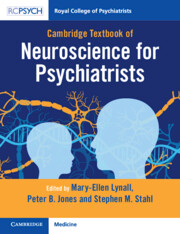Book contents
- Cambridge Textbook Of Neuroscience for Psychiatrists
- Reviews
- Cambridge Textbook of Neuroscience for Psychiatrists
- Copyright page
- Contents
- Contributors
- Introduction
- 1 Cells
- 2 Neurotransmitters and Receptors
- 3 Basic Techniques in Neuroscience
- 4 Neuroanatomy
- 5 Neural Circuits
- 6 Modulators
- 7 Genetics
- 8 Neurodevelopment and Neuroplasticity
- 9 Integrated Neurobiology of Specific Syndromes and Treatments
- 10 Neurodegeneration
- 10.1 A Neurodegenerative Cascade of Causality
- 10.2 Prodromal Disease and Mild Cognitive Impairment
- 10.3 Preclinical Stages of Neurodegenerative Disease
- 10.4 Spectra, Domains and Dimensions of Neurodegenerative Disease
- 10.5 Reserve, Resilience and Resistance to Neurodegeneration
- 10.6 Environmental Causes of Neurodegenerative Disease
- 10.7 Comorbidity and Dual Pathology in Neurodegenerative Disorders
- Index
10.6 - Environmental Causes of Neurodegenerative Disease
from 10 - Neurodegeneration
Published online by Cambridge University Press: 08 November 2023
- Cambridge Textbook Of Neuroscience for Psychiatrists
- Reviews
- Cambridge Textbook of Neuroscience for Psychiatrists
- Copyright page
- Contents
- Contributors
- Introduction
- 1 Cells
- 2 Neurotransmitters and Receptors
- 3 Basic Techniques in Neuroscience
- 4 Neuroanatomy
- 5 Neural Circuits
- 6 Modulators
- 7 Genetics
- 8 Neurodevelopment and Neuroplasticity
- 9 Integrated Neurobiology of Specific Syndromes and Treatments
- 10 Neurodegeneration
- 10.1 A Neurodegenerative Cascade of Causality
- 10.2 Prodromal Disease and Mild Cognitive Impairment
- 10.3 Preclinical Stages of Neurodegenerative Disease
- 10.4 Spectra, Domains and Dimensions of Neurodegenerative Disease
- 10.5 Reserve, Resilience and Resistance to Neurodegeneration
- 10.6 Environmental Causes of Neurodegenerative Disease
- 10.7 Comorbidity and Dual Pathology in Neurodegenerative Disorders
- Index
Summary
In the seminal report of the Lancet Commission on dementia [54] the identification of contributory risk factors, their effect size and their modifiabilty, led to a startling conclusion: as much as 40% of dementia could be prevented by immediate application of known interventions. Not by a novel disease-modifying treatment but a systematic approach to resolve and reduce risk factors across the lifespan. Early-life education; mid-life obesity, hypertension and hearing loss; and later life exercise, smoking, social isolation, diabetes, depression and pollution contribute to this potential for dementia prevention.
- Type
- Chapter
- Information
- Publisher: Cambridge University PressPrint publication year: 2023

